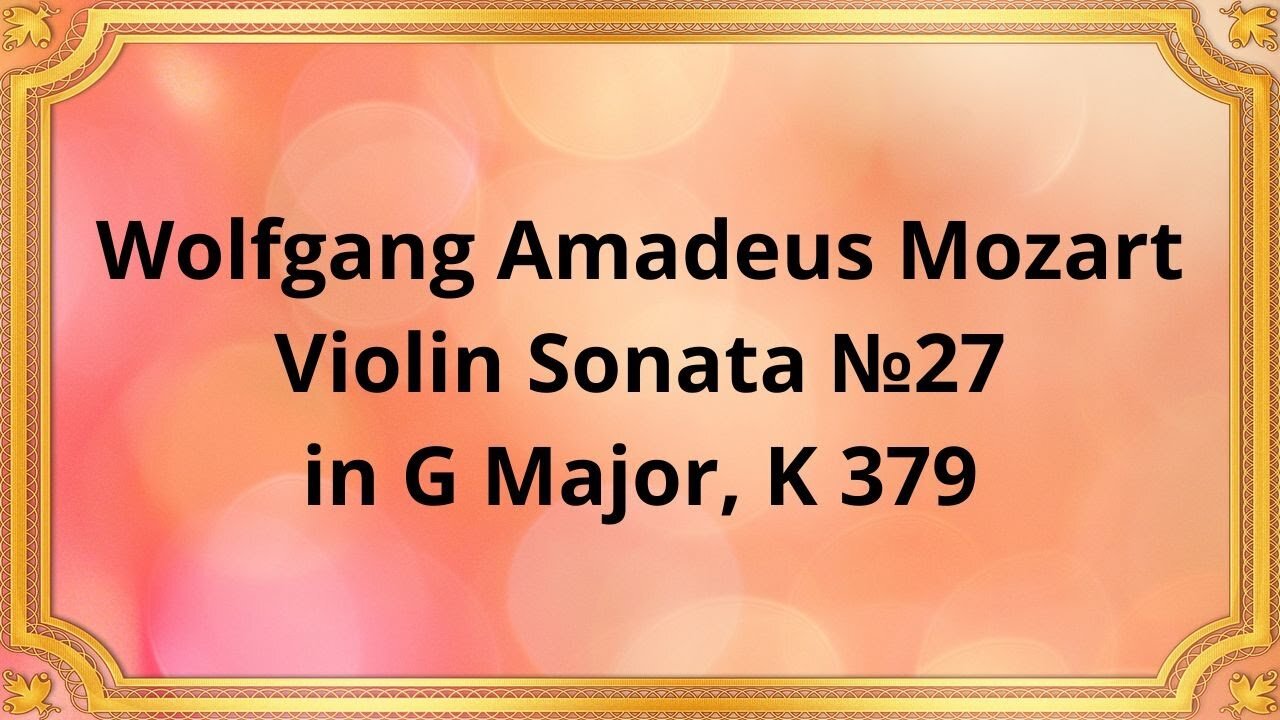Premium Only Content

Wolfgang Amadeus Mozart Violin Sonata №27 in G Major, K 379
#Mozart#Chamber_music#Classical_music#Violin_Sonata#Musical_composition
Publication date 1945
Alexander Schneider, violin; Ralph Kirkpatrick, harpsichord
Mozart's Violin Sonata No. 27 in G Major, K 379, is a brilliant example of the composer's genius in the violin sonata genre. Written in 1781, the sonata features a unique blend of technical virtuosity, expressive melodies, and rich harmonies that continue to captivate audiences and musicians today.
The sonata is structured in three movements, each with its distinct character and mood. The first movement is marked "Adagio - Allegro," and it opens with a slow and expressive melody that builds to a lively and joyful Allegro section. The second movement is marked "Theme and Variations," where Mozart takes a simple melody and transforms it into a range of musical expressions, from playful and light to introspective and somber. The final movement, marked "Allegro," is a fast and energetic piece that brings the sonata to an exhilarating conclusion.
Mozart's use of harmony and melody in this sonata is exceptional, highlighting his unique style and creativity. The sonata is written in G major, a bright and cheerful key that perfectly suits the piece's joyful and exuberant mood. The melodies are expressive and memorable, ranging from simple and elegant to complex and virtuosic. Mozart employs a range of harmonic techniques, from simple and beautiful to complex and daring, creating a rich and diverse sound world.
The sonata's technical demands are considerable, particularly for the violinist. The piece requires a high level of technical proficiency, including rapid finger work, challenging bowing techniques, and complex musical phrasing. Mozart's writing for the violin is highly idiomatic, showcasing the instrument's full range of expressive possibilities.
Mozart's Violin Sonata No. 27 in G Major, K 379, has had a significant impact on the development of the violin sonata genre. Its technical demands and expressive depth have inspired generations of violinists and composers, from Beethoven to Brahms. The sonata remains a popular and frequently performed work to this day, a testament to Mozart's enduring legacy as one of the greatest composers in history.
Conclusion:
Mozart's Violin Sonata No. 27 in G Major, K 379, is a masterpiece of musical composition, showcasing the composer's exceptional talent and skill. Its beautiful harmonies, intricate melodies, and technical demands make it a favorite of audiences and musicians alike. As a cornerstone of the violin sonata genre, the sonata remains a vital and influential work in the classical music canon, continuing to inspire and move audiences over two centuries after its creation.
-
 6:07
6:07
Classical music_Music Inspiration
14 days agoJoseph Haydn Piano Sonata in D Major, Hob. XVI:51
531 -
 14:34
14:34
Misha Petrov
13 hours agoTikTok’s WOKE “Mean Girl” Is Insufferable
11.5K10 -
 10:46
10:46
Mike Rowe
22 hours agoRiley Gaines Was Right All Along | The Way I Heard It with Mike Rowe
29K34 -
 25:19
25:19
SB Mowing
1 day agoI had to do a DOUBLE TAKE because I couldn’t see the house at first
16.7K4 -
 2:37:42
2:37:42
FreshandFit
12 hours agoGreg Doucette Guessed Their Body Fat Percentages And THIS Happened...
102K85 -
 5:08:30
5:08:30
Akademiks
13 hours agoKendrick Lamar SPEAKS for first time SINCE BEEF in new Interview. Drake preppin new album. YE WYLING
146K24 -
 2:12:17
2:12:17
Tucker Carlson
13 hours agoMike Benz Takes Us Down the USAID Rabbit Hole (It’s Worse Than You Think)
256K671 -
 1:47:17
1:47:17
Roseanne Barr
17 hours ago $34.83 earnedThe Most Offensive Comic, Leonarda Jonie | The Roseanne Barr Podcast #86
149K170 -
 51:45
51:45
Talk Nerdy 2 Us
15 hours ago🔥 Talk Nerdy 2 Us – Feb 7th: HACKED, TRACKED & UNDER ATTACK! 🔥
114K8 -
 18:47
18:47
Degenerate Plays
20 hours agoThey're In Paris And At Freddy's? - Five Nights At Freddy's 4 : Finale
431